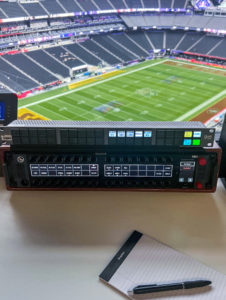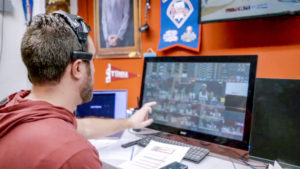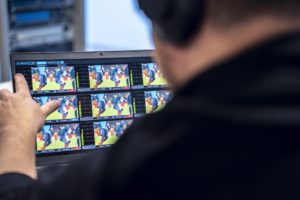It is clear that there is considerable consumer interest in Ultra HD – 4k resolution and high dynamic range colour. Particularly for sports, it presents much more detail, so is more engaging and involving.
There was a tendency to think that the only way to deliver Ultra HD is through an IP network, probably using SMPTE ST2110. But early adopters have found it operationally difficult. Particularly in the high pressure world of live events and outside broadcasts, configuring and managing networks is a much more demanding task than simply plugging in SDI cables.
There is much to be said for SDI. It is robust and comprehensively understood by engineers. With 12G technology it can support Ultra HD over a single cable, the way we have done since standard definition days. True, there are transmission challenges with Ultra HD over 12G SDI, but with care in the cabling and the right hardware, it is perfectly possible to get the high reliability we expect: for outside broadcasts it is ideal.
12G routing may not be as compact as an enterprise IT switch, but SDI has been with us a long time, and by now it is pretty much bullet-proof. That is why, for many, it is the pragmatic, practical option.
FOR-A is a Japanese company, and we have recently celebrated our 50th anniversary in the business. While we are a global supplier, inevitably we are influenced by our home market. That is a good thing: as a nation Japan was an early adopter of Ultra HD (and even higher resolutions), so we were actively encouraged to develop innovative products to support it.
Japan was also host to a major multi-sports event earlier this year, which was a global showcase for broadcast technology, and what the host broadcasters could deliver. Drawing on its unrivalled Ultra HD experience, it largely went with 12G SDI.
There are many practical issues around producing large-scale, premium quality sports coverage in Ultra HD. Perhaps the most significant of these is that you have to have a single production workflow, from camera to delivery. Doubling any part of the pipeline would be economically catastrophic.
So we have to work on the basis of one set of cameras. Having separate HD and Ultra HD cameras would also increase the seat-take in the stadium, which is never popular. Those cameras have to feed a single production switcher, with a director choosing shots on a single multiviewer.
Not all cameras will be Ultra HD. It may not be practical or cost-effective to equip point-of-view positions – football goalmouths, cricket stumpcams and so on – with Ultra HD cameras. So you have to up-res these HD cameras to Ultra HD before the switcher. You may also have to do some colour processing to match the colorimetry with the main cameras.
This processing needs to be extremely low latency: sports fans above all others notice time jumps, when they want to know precisely what is happening at this very instant.
HDR and its associate extended colour gamut is also hugely popular. But there are multiple ways of encoding HDR, so the infrastructure also has to include transcoders between HDR10, HLG, PQ and more. Production in one HDR format and distribution in another is quite common.
Another layer of the production chain is the expectation that key action points will be replayed, and that slow motion replays will bring the audience closer to the action, more involved in the fine detail of the decision-making. Did that ball cross the line? Did the ball hit bat or pad first?
Smooth slow-motion replays demand high speed cameras, with the direct correlation that the more detailed the replay, the higher the frame rate recorded. The latest model from FOR-A shoots at up to 1000 frames a second, which means that one second of crucial action could be replayed over 40 seconds, perfectly smoothly without interpolating frames.
Such replays are only possible during breaks in the action, of course. But there is no doubt that they add tremendously to emotion and understanding for the viewer.
Super slo-mo cameras are subject to the same requirements as the rest of the production. It is not economical to have a separate operator, not practical to take more seats to create the perfect camera placement. Which means that the super slo-mo cameras must have a conventional, realtime output: in Ultra HD, with the same image quality as the rest of the camera fleet so pictures can be inter-cut without disturbance.
Finally, there is the age-old problem of frame rates. Japan is a 59.94 country, so this year’s major events were shot at that frame rate. For other markets, there has to be frame rate conversion which must be clean without hitches or freezes. And, like everything else in the production and distribution pipeline, it has to have the lowest possible latency so the audience is confident it is seeing the action as it happens.
At FOR-A we are proud to have supplied a significant number of 12G video processors to the major sports events in Tokyo, successfully fulfilling the functions I have talked about and more. As they do with many other sports and live productions, they deliver quality and flexibility, at a good price point.
12G infrastructure proved the right way for the world’s biggest multi-sports event, but for any production, large or small, there is a strong sense that it is the practical, pragmatic choice – for now at least.









